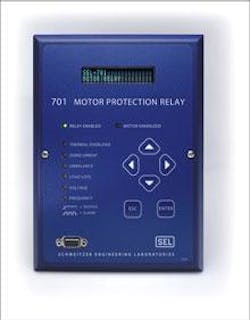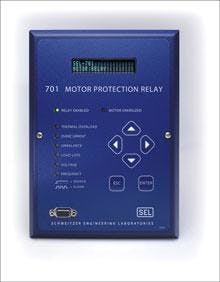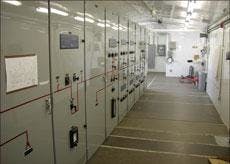Utility-Grade Relays Protect Critical Wastewater Plant Motors
The Denver-based Metro Wastewater Reclamation District, the largest wastewater treatment plant between the Mississippi River and West Coast, has some daunting challenges in its disposal of solid waste and return of clean water to the community. To provide necessary assurance of critical blower system uptime, Metro Wastewater replaced its aging motor protection relays with SEL-701 "utility-grade" relays.
Metro's water throughput from its 380-square-mile district is 150 mgd. The water it purifies contributes 90 percent of the South Platte River's annual flow at the point of discharge. Any sustained interruption of reclamation processes could therefore have a devastating impact on this vital natural resource.
With the system's huge throughput it is critical to Metro's customers and environment that water processing continue with virtually no interruptions. To ensure reliability, Metro's systems and standards are continually updated and supported by elaborate monitoring and backup equipment.
"From a practical standpoint, most equipment service is an emergency at a facility such as Metro," said Andy Leoni, Manager of Engineering at NEI Electric Power Engineering, which engineers the design and service of Metro's electrical and communications systems. "While there is backup equipment for key motors, when a motor is brought offline you have to service it right away. Otherwise, if the backup fails, the process it powers could be out of business."
Wastewater plants are inherently harsh environments for electronic equipment, due to the presence of hydrogen sulfide and dust in the air, Leoni said.
"Hydrogen sulfide causes corrosion in power system materials such as copper and silver plated copper," he said, "and this type of corrosion is very hostile to protective relays and electronic controls."
For the past six years NEI has been studying and redesigning the entire Metro power system. Of specific concern were the electric motor protection relays that protected the motors powering several 15 kV and 5 kV aeration blowers.
"The usual 'industrial-grade' relays that were already in use didn't provide the reliability or security we wanted," Leoni said. "Inconsistent performance and lack of product support were causing a great deal of coordination problems and occasional equipment failures, including relay and control logic failures. When one or more blower motors quit, part of Metro's treatment capacity would be temporarily disabled. Worse yet, if such an event were to go undetected, EPA violations could occur - a situation that Metro was determined to prevent."
Of further concern was the fact that the industrial-grade relays Metro had been using were expensive to replace and required long lead-times for delivery.
A "Utility-Grade" Solution
Dissatisfied with the idea of replacing worn or failed relays with similar equipment, in mid-1999 NEI began to look for more rugged relays to protect the Metro aeration blower motors. The relays they selected were from Schweitzer Engineering Laboratories (SEL), well established in the utility industry for manufacturing durable products.
"We had been using SEL relays extensively with our utility and industrial customers," Leoni said. "Metro's engineers and maintenance personnel were very satisfied with the previous retrofits at their plant, and it took little convincing to adopt SEL products as the standard for medium voltage protection applications. However, during the initial design stages, SEL did not have a motor protection relay possessing the features most industrial users desire."
Consultation with Walt Slade of KD Johnson, the regional distributor for Schweitzer, confirmed that the company had a robust product in development that would meet Metro's present and future needs, the SEL-701 Motor Protection Relay. The SEL-701 offered not only complete protection features, but also a range of communications, monitoring and metering capabilities.
"Prior to the introduction of the SEL-701, we were considering motor protection relays other than those manufactured by SEL. Once the SEL-701 was introduced and we had a chance to evaluate it, we were impressed enough to recommend it as the standard for Metro," Leoni said.
Metro's Project Manager and electrical engineer, Jean Larsen, concurred with recommendation, and the SEL-701 was incorporated into the system design.
While completing design for the plant, one of the pre-existing "industrial grade" relays failed. Metro's maintenance supervisor, Jim Carabajal, and maintenance planner, Larry Dulworth, contacted NEI, in dire need.
"We had contacted the manufacturer of the failed relay (the second failure in about 10 years). The price and delivery seemed outrageous, so we asked Andy if we could use a 'retrofit' SEL-701 instead," said Dulworth. "Amazingly, this utility-grade device was not only more durable and robust than the industrial-grade counterpart, but it was also less expensive and required much less lead time for delivery."
Among the SEL-701's features is the Sequential Events Recorder (SER) to report faults and act as an analytical tool, as well as its integral metering and communications functions.
NEI first introduced Metro to Schweitzer products in the cogeneration section of the Metro plant. The anaerobic digestion process used to produce biosolids also produces methane, which was used to fuel four large electrical generators and heat the 10 anaerobic digesters as well as provide electrical power and heat to other buildings on the plant site. Most of the electrical power was sold to Public Service of Colorado, generating about $1.6 million in revenues per year.
When that contract expired, two new, more efficient, gas turbine units were installed. As with the old system, the new gas turbines had to meet Public Service's system interconnect requirements, which was accomplished with Schweitzer's SEL-351 and 300G relays. The SEL-351 units were connected via a SEL-2030 communications processor to the existing distributed control system.
NEI's redesign of Metro systems places some emphasis on system integration, automation and communications. A new fiber optic network will soon be installed, connecting all of the SEL-2030's and their associated relays to Metro's distributed control system. Schweitzer equipment is now standard on all medium-voltage equipment throughout the wastewater treatment operation.
When construction is complete, NEI and Metro will have installed eight SEL-701 motor protection relays, six SEL-2030 communications processors, two SEL-587 current differential relays, two SEL-501 overcurrent relays, two SEL-300G generator relays and approximately 35 SEL-351 relays.


